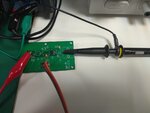danadakk
Advanced Member level 6
Have you posted over at Analog Devices forum, or contact their sales
office, just to make sure there is not a bad batch of parts out there. The
testing you did loading C onto various nodes with little change in freq
indicates to me its part internal issue. If there is a bad batch they should
be able to supply data codes of problem part runs.
Regards, Dana.
office, just to make sure there is not a bad batch of parts out there. The
testing you did loading C onto various nodes with little change in freq
indicates to me its part internal issue. If there is a bad batch they should
be able to supply data codes of problem part runs.
Regards, Dana.
